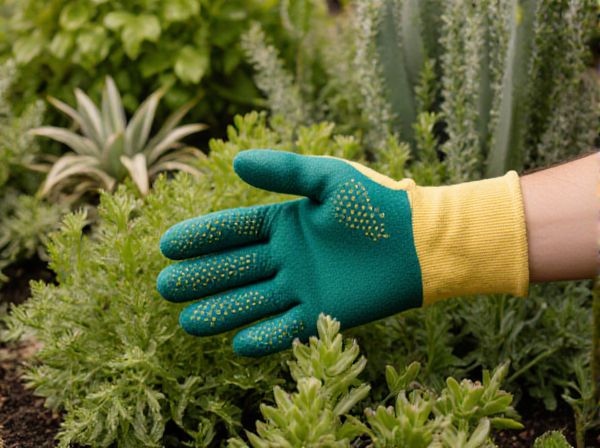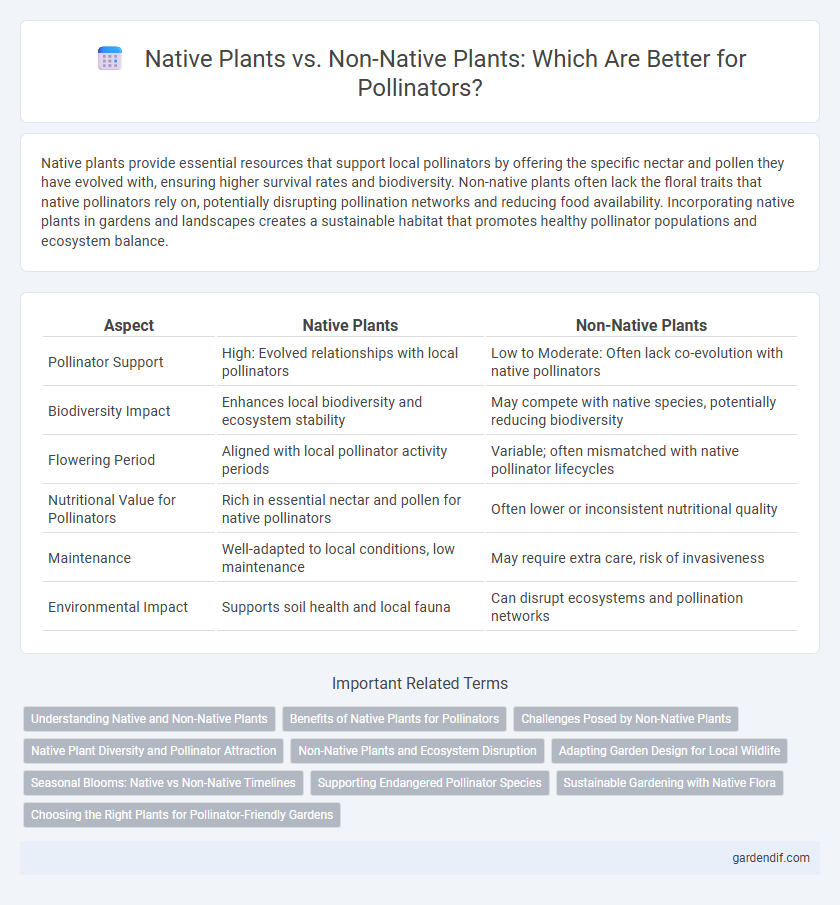
Native plants vs Non-native plants Illustration
Native plants provide essential resources that support local pollinators by offering the specific nectar and pollen they have evolved with, ensuring higher survival rates and biodiversity. Non-native plants often lack the floral traits that native pollinators rely on, potentially disrupting pollination networks and reducing food availability. Incorporating native plants in gardens and landscapes creates a sustainable habitat that promotes healthy pollinator populations and ecosystem balance.
Table of Comparison
| Aspect | Native Plants | Non-Native Plants |
|---|---|---|
| Pollinator Support | High: Evolved relationships with local pollinators | Low to Moderate: Often lack co-evolution with native pollinators |
| Biodiversity Impact | Enhances local biodiversity and ecosystem stability | May compete with native species, potentially reducing biodiversity |
| Flowering Period | Aligned with local pollinator activity periods | Variable; often mismatched with native pollinator lifecycles |
| Nutritional Value for Pollinators | Rich in essential nectar and pollen for native pollinators | Often lower or inconsistent nutritional quality |
| Maintenance | Well-adapted to local conditions, low maintenance | May require extra care, risk of invasiveness |
| Environmental Impact | Supports soil health and local fauna | Can disrupt ecosystems and pollination networks |
Understanding Native and Non-Native Plants
Native plants support local pollinators by providing essential nectar, pollen, and habitat evolved together within the same ecosystem, fostering biodiversity and ecosystem stability. Non-native plants may sometimes offer floral resources but often lack the specific nutritional quality or timing that native pollinators require, potentially disrupting native pollinator populations. Understanding the distinct roles and impacts of native versus non-native plants helps guide effective pollinator conservation and restoration efforts.
Benefits of Native Plants for Pollinators
Native plants provide crucial habitats and food sources tailored to local pollinators, enhancing their survival and reproduction. Their coevolution with indigenous insects ensures higher nectar and pollen availability, supporting diverse pollinator populations more effectively than non-native species. Native flora also promotes ecosystem stability by sustaining native pollinator networks and reducing reliance on chemical inputs.
Challenges Posed by Non-Native Plants
Non-native plants often disrupt local ecosystems by outcompeting native flora, reducing the availability of nectar and pollen essential for native pollinators like bees, butterflies, and hummingbirds. These invasive species can alter habitat structure and phenology, leading to mismatches in pollinator feeding times and breeding cycles, which harms biodiversity. The spread of non-native plants also introduces diseases and pests that native plants and pollinators have no resistance to, further threatening pollination networks and ecosystem health.
Native Plant Diversity and Pollinator Attraction
Native plants enhance pollinator attraction by providing a diverse range of nectar and pollen sources specifically adapted to local pollinators. This diversity supports a wider variety of native pollinator species compared to non-native plants, which often lack the specialized traits needed by indigenous pollinators. Studies show ecosystems with high native plant diversity exhibit increased pollinator abundance and improved ecological resilience.
Non-Native Plants and Ecosystem Disruption
Non-native plants often outcompete native species, leading to reduced biodiversity and altered habitats essential for pollinators. These invasive species can disrupt mutualistic relationships between native plants and pollinators, resulting in decreased pollination efficiency and pollinator population declines. Ecosystem disruptions caused by non-native plants undermine the resilience and stability of native pollinator networks.
Adapting Garden Design for Local Wildlife
Incorporating native plants in garden design enhances pollinator support by providing species-specific nectar and pollen essential for local bees, butterflies, and hummingbirds. Native flora adapts naturally to the region's climate and soil, promoting sustainable habitats and minimizing resource-intensive maintenance. Non-native plants often lack the nutritional value or bloom timing suited to indigenous pollinators, potentially disrupting local ecosystems and reducing biodiversity.
Seasonal Blooms: Native vs Non-Native Timelines
Native plants exhibit synchronized seasonal bloom timelines that align with local pollinator life cycles, ensuring optimal food resources during critical periods. Non-native plants often bloom at mismatched times, which can disrupt pollinator feeding patterns and reduce overall ecosystem support. Emphasizing native species in landscapes enhances pollinator health by providing consistent and timed nectar and pollen availability throughout the growing season.
Supporting Endangered Pollinator Species
Native plants provide essential habitat and specialized nectar sources critical for endangered pollinator species, ensuring their survival and reproductive success. Non-native plants often lack the specific nutritional profiles required by native pollinators, potentially reducing foraging efficiency and increasing stress on vulnerable populations. Supporting native flora in restoration efforts enhances biodiversity and strengthens ecological resilience for at-risk pollinator species.
Sustainable Gardening with Native Flora
Native plants provide essential habitat and food sources for local pollinators, supporting biodiversity and ecosystem resilience in sustainable gardening. Non-native plants often lack the specific relationships with indigenous pollinators, leading to reduced pollination efficiency and potential disruption of local ecosystems. Emphasizing native flora in gardening enhances pollinator populations, conserves native species, and promotes long-term sustainability.
Choosing the Right Plants for Pollinator-Friendly Gardens
Native plants support local pollinators by providing tailored nectar, pollen, and habitat that non-native plants often lack, leading to higher pollination efficiency and biodiversity. These plants have co-evolved with native bees, butterflies, and other pollinators, ensuring optimal synchronization with their life cycles. Selecting native species such as milkweed, purple coneflower, and goldenrod enhances garden resilience and sustains local ecosystems by attracting and sustaining native pollinator populations.
Native plants vs Non-native plants Infographic

 gardendif.com
gardendif.com